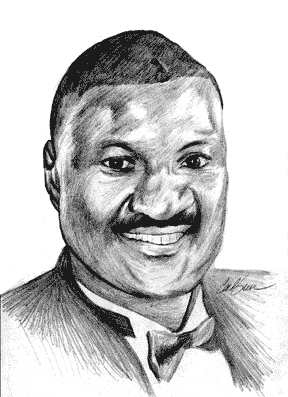INTERVIEW
Purely Technical
Hamilton Lewis
by John Sweeney and Bruce Faber
From the day he arrived in the US from Liberia, Hamilton Lewis's persistence took him through the securities industry's maturation process to become a money manager with $95 million under his guidance. The unique thing about that? Lewis manages it all with technical tools, and classic tools at that: he's a point-and-figure man, with a dash of cyclic analysis and candlestick charting thrown in. Currently based in Houston, TX, Lewis does a daily review of 300 actively traded equities, updating his charts by hand as he does so. STOCKS & COMMODITIES Technical Editor John Sweeney and Staff Writer Bruce Faber interviewed Hamilton Lewis via telephone on August 20 and August 23, 1999, asking him about his background, how an active manager speculates purely with technical tools, and his results in doing so.

ILLUSTRATION BY CARL GREEN
How did you get started with your interest in the stock market?
Eighteen years ago, I escaped to this country from Monrovia, Liberia, with $400 in my pocket. I had been playing on the Liberian national basketball team, so I managed to get an athletic scholarship to play college basketball.
What did you study?
Financial management. While I was at college, one of my professors told me that I had a good way of working with people and finance. He also told me that he believed that financial planning would be the wave of the future, and I should consider that.
Had you already been studying finance at that point, or did you just take a finance survey course?
No. From day 1, I wanted to major in finance and management because I like people and money. I knew that there was always a need for people to know about money, so I wanted to study about it. Of course, finance is kind of boring until you get to the investments part of the course. My finance professor said this was an opportunity whereby you could turn a dollar into $10 just by using brainpower. So that was intriguing.
What did you do?
After I graduated, I started working in the mailroom at a company called Sunstrand Securities. Eventually, I got promoted to making cold calls for vice presidents.
What happened?
I called my old accounting professor purely by coincidence. I didn't know until I got him on the phone that he was the one on the cold-call lead. He recognized my name, and told me that I should be doing cold calls for myself, not for someone else.
Did you listen to him?
Yes, I did. That was quite a revelation. You graduate from college. You don't know what you are doing, so if you are willing to listen to what others tell you, you can make it big. I listened to my old professor, and four months later I started work at I-Tech Securities, where I could get my Series 7 license to start cold-calling for myself and start building my own business.
How long were you there?
Just a few months. One of the vice presidents at I-Tech told me I should consider going to Merrill Lynch, because, he said, when you call people from Merrill Lynch, the people know why you are calling, and you can really get off the ground, as opposed to a smaller firm without that name recognition. So I went to a Merrill Lynch here in Houston. Well, they told me, "Not enough experience," but they said they would pay me $1,200 to cold-call. I said I'd already done that.
So what did you do?
I went to another Merrill office and they hired me, and I said, "I am ready to start right now." They said, "No, Monday!" I said, "No, no. Now!" I told the manager I was willing to work free for 30 days, and if I didn't open more accounts than he had ever seen a rookie open, he should fire me. He told me, "You're in America now, you're not in Africa. People don't work for free here."
By charting by hand, you get a keen understanding of where the market is. You can talk about what's going on in the marketplace from your heart. -- Hamilton Lewis
Excerpted from an article originally published in the November 1999 issue of Technical Analysis of STOCKS & COMMODITIES magazine. All rights reserved. © Copyright 1999, Technical Analysis, Inc.
Return to November 1999 Contents